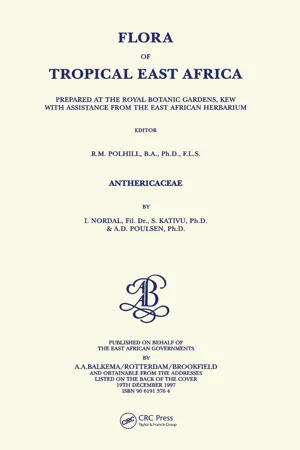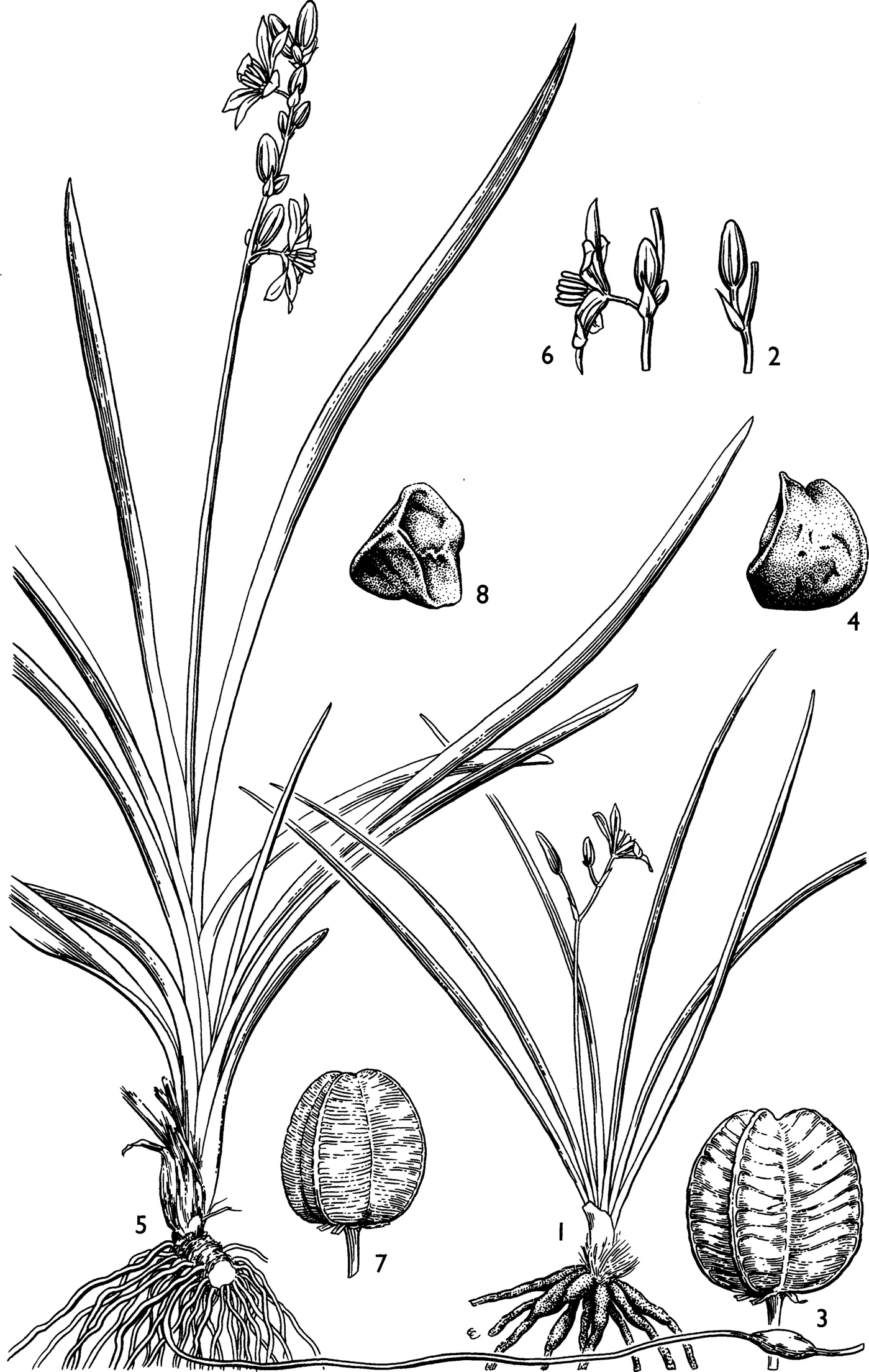
eBook - ePub
Flora of Tropical East Africa - Anthericaceae (1997)
This is a test
- 280 pages
- English
- ePUB (mobile friendly)
- Available on iOS & Android
eBook - ePub
Flora of Tropical East Africa - Anthericaceae (1997)
Book details
Book preview
Table of contents
Citations
About This Book
The Flora is prepared at the Royal Botanic Gardens, Kew in close collaboration with East African Herbarium and in liaison with the University of Dar es Salaam, the University of Nairobi and the Makerere University. Significant contributions are also made by specialists elsewhere. This reference should be of use to anyone concerned with the identification and utilization of plants in eastern Africa.
Frequently asked questions
At the moment all of our mobile-responsive ePub books are available to download via the app. Most of our PDFs are also available to download and we're working on making the final remaining ones downloadable now. Learn more here.
Both plans give you full access to the library and all of Perlego’s features. The only differences are the price and subscription period: With the annual plan you’ll save around 30% compared to 12 months on the monthly plan.
We are an online textbook subscription service, where you can get access to an entire online library for less than the price of a single book per month. With over 1 million books across 1000+ topics, we’ve got you covered! Learn more here.
Look out for the read-aloud symbol on your next book to see if you can listen to it. The read-aloud tool reads text aloud for you, highlighting the text as it is being read. You can pause it, speed it up and slow it down. Learn more here.
Yes, you can access Flora of Tropical East Africa - Anthericaceae (1997) by Linger Nordal,Shakkie Kativu,Axel D. Poulsen in PDF and/or ePUB format, as well as other popular books in Biological Sciences & Horticulture. We have over one million books available in our catalogue for you to explore.
Information
FLORA OF TROPICAL EAST AFRICA
_____
ANTHERICACEAE
INGER NORDAL (University of Oslo), SHAKKIE KATIVU (University of Zimbabwe) & AXEL D. POULSEN (University of Copenhagen)
Perennial herbs with rhizomes or corms, these whitish inside (not yellowish as in the closely related family Asphodelaceae). Leaves in a basal rosette, usually rosulate, sometimes subdistichous to distichous, with or without a pseudopetiole (later called petiole), linear to lanceolate, rarely terete; outer leaves often with reduced lamina (cataphylls). Peduncle usually leafless (ebracteate), sometimes with ± bract-like leaves (bracteate). Inflorescence paniculate, racemose or spicate. Flowers bisexual, hypogynous, regular to slightly irregular; tepals in two whorls of 3+3 (equal or subequal), free, white or whitish, often keeled with a coloured line of greenish, reddish or brownish; stamens 3+3, free; filaments filiform to fusiform; anthers basifixed, with longitudinally introrse dehiscence. Ovaries with several ovules per locule, developing into a loculicidal capsule. Seeds flat or folded, rarely turgid, black, ± glossy, without an aril (not dull and arillate as in Asphodelaceae).
A tropical to temperate family with 8 genera, of which 2 occur in Africa; the number of species is difficult to estimate due to uncertain delimitation at different levels. The family is closely related to Asphodelaceae, from which it may sometimes be difficult to distinguish by its gross morphology. Representatives of Asphodelaceae, however, always contain anthraquinones, displayed especially by the rhizomes which are yellowish when cut; in Anthericaceae the rhizome is always whitish inside. The seeds of Asphodelaceae are covered by a thin aril, making them brownish to greyish and dull; in Anthericaceae the seeds are always black, sometimes glossy.
| Roots ± swollen, without tubers; flowers solitary at each node of the inflorescence, supported by only one bract; pedicels without a joint; seeds ± turgid | 1. Anthericum |
| Roots swollen or, if not, bearing tubers; flowers usually more than one at each node of the inflorescence or, if only one then supported by two bracts; pedicels generally articulated; seeds ± thin, flat or folded | 2. Chlorophytum |
L., Sp. Pl.: 310 (1753); Baker in F.T.A. 7: 477 (1898), pro parte; Oberm. in Bothalia 7: 669-767 (1962), pro parte; Nordal et al. in Mitt. Inst. Allg. Bot. Hamburg 23: 535-559 (1990); Kativu & Nordal in Nordic Journ. Bot. 13: 59-65 (1993); Nordal & Thulin in Nordic Journ. Bot. 13: 257-280 (1993)
Small plants, up to 20 cm. tall. Rhizome very short; roots ± swollen, without tubers. Cataphylls membranous, often hidden by fibrous remnants from previous years’ leaves. Leaves in a basal rosette, linear to ± succulent. Peduncles leafless, often several to a plant, reduced, within the leaf rosette, or elongated, up to 15 cm. Inflorescence umbel-like (pedicels then emerging from inside the leaf rosette) or a simple raceme; pedicels 1 per node, subtended by a single bract, never articulated. Perianth persistent as fruit matures. Tepals white, often with greenish tinge or stripe outside. Filaments filiform, smooth. Capsule rounded or shallowly 3-lobed in cross-section. Seeds turgid, only slightly folded.
A mainly Old World temperate genus with ± 10 species.
| 1. Peduncle completely reduced; inflorescence umbel-like, the pedicels 3-8 cm. long, emerging directly from the leaf rosette | 1. A. angustifolium |
| Peduncle distinct, up to 15 cm. long; inflorescence racemose, unbranched or with few basal branches, pedicels shorter than 2.5 cm. | 2 |
| 2. Leaves ± 0.5 cm. wide, semi-succulent to fistulose; inflorescence never branched; capsule slightly ridged, but not verrucose | 2. A. corymbosum |
| Leaves ± 1 cm. wide, flat; inflorescence often with 1-3 basal branches; capsule verrucose | 3. A. jamesii |
1. A. angustifoliumA. Rich., Tent. Fl. Abyss. 2: 331 (1850); Baker in F.T.A. 7: 489 (1898); W.F.K: 117 (1948); Polhill in Journ. E. Afr. Nat. Hist. Soc. 24: 6 (1962); E.P.A.: 1530 (1971); Blundell, Wild Fl . E. Afr., reprint: 418 (1992); Nordal & Thulin in Nordic Journ. Bot. 13: 258 (1993); U.K.W.F., ed. 2: 316, t. 144 (1994); Nordal in Fl. Ethiopia 6: 90 (1997). Lectotype, chosen by Nordal & Thulin (1993): Ethiopia, Tigray, Chiré, Quartin-Dillon (P, lecto.!, K, isolecto.!)
Small plants up to ± 15 cm. Leaves linear, 5-15 cm. long, 2-5 mm. wide, glabrous or with ciliate margins. Peduncle very short and hidden among the leaves; rhachis almost completely reduced, making the inflorescence umbel-like. Pedicels 3-8 cm. long. Flowers white, greenish tinged outside, star-like, 2-10 to a plant; tepals 8-12 mm. long, 2-3 mm. wide, 3-veined. Stamens shorter than the tepals, with filaments up to 4 mm. long; the yellow anthers shorter and curled after anthesis. Capsule subglobose, 5-8 mm. long, smooth or slightly ridged, on lax pedicels so that they end up lying on the ground. Seeds ± 2 mm. in diameter.
UGANDA. Mbale District: Sebei, Kaburoron [Kabururon], 15 May 1955, Norman 259!
KENYA. Northern Frontier Province: Lorogi Plateau, Kisima, 14 Apr. 1977, Timberlake 1034!; SW. Elgon, 11 May 1958, Symes 358!; Nakuru District: Ndoinet R. valley, 28 Mar. 1970, Gillett 19025!; Londiani, near forest office, 13 May 1949, Maas Geesteranus 4650!
DISTR. U 3; K 1, 3, 5; Eritrea and Ethiopia
HAB. Growing in clumps in upland grassland, seasonally waterlogged, often heavily grazed and eroded, on shallow and gritty black or lateritic soils, sometimes in crevices in the rock; 1800-2850 m.
SYN. A. humile A. Rich., Tent. Fl. Abyss. 2: 331 (1850); Baker in F.T.A. 7: 489 (1898); E.P.A.: 1531 (1971). Lectotype, chosen by Cufod. (1971): Ethiopia, Tigray, Oudgerate, Petit (P, lecto.!, K, isolecto.!)
2. A. corymbosum Baker in J.B. 15: 71 (1877) & in F.T.A. 7: 489 (1898); W.F.K.: 117 (1948); E.P.A.: 1530 (1971); Nordal & Thulin in Nordic Journ. Bot. 13: 258 (1993); U.K.W.F., ed. 2: 316 (1994); Thulin, Fl. Somalia 4: 42, fig. 26 (1995); Nordal in Fl. Ethiopia 6: 91 (1997). Type: Somalia, Meid, Mt. Surrut, Hildebrandt 1471 (K, holo.!)
Plants 10-20 cm. Leaves linear, 5-25 cm. long, 1-8 mm. wide, ± succulent, often with ciliate margins. Peduncles 3-15 cm. long, glabrous. Inflorescence a simple raceme, 3-7 cm. long, with 3-15 flowers; floral bracts membranous, cuspidate, up to 12 mm. long. Pedicels semipatent, sometimes drooping in fruit, 5-25 mm. long, elongating to 40 mm. with age. Tepals white with green stripes on the outside, 9-10 mm. long, 2-3 mm. wide. Stamens shorter than the tepals, with filaments up to 4 mm. long; the yellow-orange anthers shorter and curled after anthesis. Capsule subglobose with a rounded triangular cross-section, 3-8 mm. long, slightly ridged, but not verrucose. Seeds 2-3 mm. across. Fig. 1/1-4.

FIG. 1. ANTHERICUM CORYMBOSUM — 1, habit, × ⅔; 2, node of inflorescence, × 1; 3, capsule, × 2; 4, seed, × 8. CHLOROPHYTUM CAMERONII var. PTEROCAULON — 5, habit, × ⅔; 6, node of inflorescence, × 1; 7, capsule, × 2; 8, seed, x 8. 1, 2, from Mathew 6039; 3, 4, from Polhill 372A; 5, 6, from Mathew & Hanid 6050; 7, 8, from Bidgood, Mwasumbi & Vollesen 1226. Drawn by Eleanor Catherine.
KENYA. Northern Frontier Province: Moyale, 17 Apr. 1952, Gillett 12834!; Naivasha District: Gilgil to Naivasha road, near Ilkek Station, 13 Apr. 1970, Mathew 6039!; Nairobi National Park, 22 1973, Gillett & White 20233!
TANZANIA. Serengeti, 15 km. SW. of Haibardad, 17 Dec. 1973, Kreulen 207!; Masai District: S. Serengeti, Mpitin, 22 Dec. 1962, Newbould 6429! & Ngorongoro Conservation Area, Esere, 3 Dec. 1989, Chuwa 3061!
DISTR. K 1, 3, 4, 6; T 1, 2; Ethiopia and Somalia
HAB. Growing in clumps in depressions in grassland, bushland and degraded Acacia-Co...
Table of contents
- Cover
- Title Page
- Copyright Page
- Anthericaceae
- Index to Anthericaceae
- Geographical Divisions of the Flora